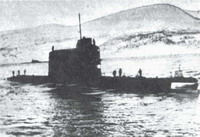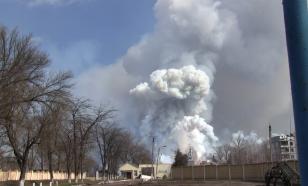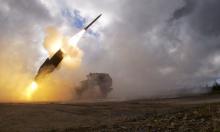Russia unveils the mystery of sunken K-129 submarine
Russian authorities got from U.S. a videotape and other archival materials on the fate of the Soviet K-129 submarine.

At a ceremony in the Far Eastern port of Vladivostok, U.S. officials gave Russia's Pacific Fleet archive and museum copies of formerly classified documents, including two ship logs related to the K-129 incident and to U.S. efforts to salvage the sub from the sea floor in the central Pacific.
Also turned over was a videotape of a secret burial-at-sea for six Soviet sailors whose bodies were recovered when the United States tried to salvage the sub.
"We have a debt to servicemen. If I were to go missing, I would want someone to work - like what I am doing - to communicate to my mother and father what exactly happened with me," U.S. Lt. Col. Michael O'Hara said in comments shown on Russia's NTV television.
O'Hara works with the US-Russian Joint Commission on POW/MIAs, a body created 15 years ago to help account for all U.S. military personnel who went missing during the Cold War.
Roger Schumacher, the Washington-based deputy director supporting the Joint Commission, said much of the material donated Monday had been handed over previously to Russian defense, government or intelligence experts.
Other items related to the K-129 sinking that were given over earlier included the sub's bell and a photography camera apparently used by a sailor on board the ship, he said. U.S. underwater photographs of the sunken sub have not been given to the Russians, despite repeated requests.
It was unclear whether Monday's ceremony would help assuage the persistent suspicions that Russian naval officials and relatives have had about the fate of the K-129 - a Golf-II class, nuclear-missile armed, diesel-electric submarine that had 98 seamen on board when it sank in 16,000 feet (4,880 meters) of water northwest of the Hawaiian island of Oahu on March 11, 1968.
Russian officials long have suspected that the K-129 was struck by an American submarine, the USS Swordfish. But the U.S. Navy says the vessel suffered a catastrophic internal explosion.
Retired Capt. 1st Rank Pavel Dementiev said the sub's captain, Vladimir Kobzar, and his commanding officer, Rear Admiral Viktor A. Dygalo, were both experienced and talented naval officers.
"There is just one version - that (K-129) collided with an American submarine," he said in televised comments.
Russian doubts about the U.S. explanation of the K-129's fate re-emerged in 2000 with the sinking of the nuclear submarine Kursk. Many military officials suspected that the Kursk collided with an American or British submarine. U.S. and British officials denied the allegations, but the U.S. officials acknowledged that two U.S. submarines were close enough to record the sound of enormous explosions aboard the Kursk.
Russian suspicions about the Swordfish were based on records indicating it underwent nighttime repair of a bent periscope at Yokosuka, Japan, on March 17 - six days after the K-129 sank - and Moscow has requested the Swordfish's deck logs, to trace its movements. The Pentagon has explained the Swordfish repairs in Japan by saying the ship had collided with an ice pack and was 2,000 miles (3,218 kilometers) away from the Soviet sub when it sank.
Russian officials also say that the U.S. salvage operations in 1968 and 1974 removed highly sensitive equipment _ possibly including nuclear warheads. During the 1974 efforts, the CIA-financed Glomar Explorer salvage ship tried raising the sub, but it broke apart and only some sections were recovered.
Schumacher said excerpts from the deck logs of the Swordfish and the USS Halibut, a nuclear submarine that was in the area at the time of the sinking, were turned over to Russian officials in 1995.
U.S. officials had earlier provided the burial-at-sea videotape for the six crew members whose remains were recovered during the 1974 salvage efforts. The videotape, parts of which were broadcast by Russian TV Monday, had reportedly been shown to relatives of crew members at an earlier date.
Also turned over to Russian officials Monday was a list of nine U.S. reconnaissance aircraft lost and believed shot down by Soviet forces in and near the Russian Far East between 1951 and 1956, Schumacher said. U.S. officials are hoping the Russians will help provide details as to the whereabouts of the crashes and the fates of the 77 crew members.
Subscribe to Pravda.Ru Telegram channel, Facebook, RSS!


